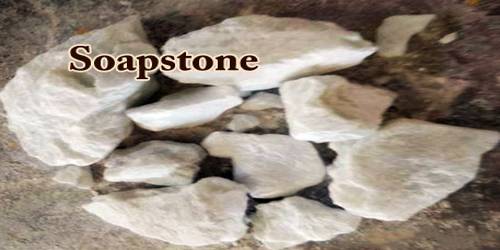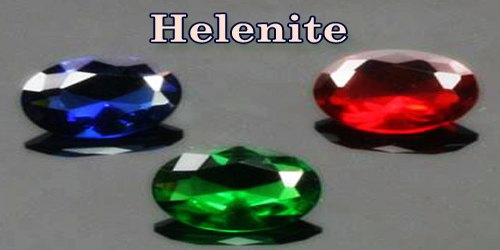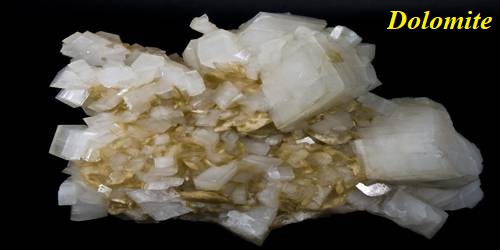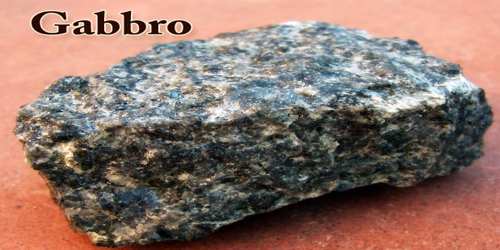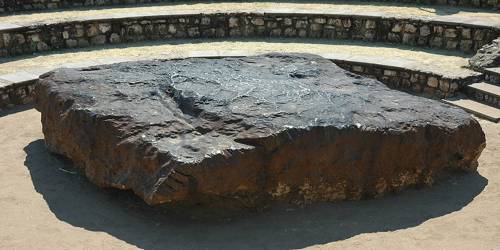Definition –
Soapstone (also known as steatite or soaprock) is a metamorphic rock that is composed primarily of talc, with varying amounts of chlorite, pyroxenes, micas, amphiboles, carbonates, and other minerals. Because it is composed primarily of talc it is usually very soft. Soapstone is typically gray, bluish, green, or brown in color, often variegated. Its name is derived from its “soapy” feel and softness.
It is produced by dynamothermal metamorphism and metasomatism, which occur in the zones where tectonic plates are subducted, changing rocks by heat and pressure, with influx of fluids, but without melting. It has been a medium for carving for thousands of years.
The name “soapstone” is often used in other ways. Miners and drillers use the name for any soft rock that is soapy or slippery to the touch. In the craft marketplace, sculptures and ornamental objects made from soft rocks such as alabaster or serpentine are often said to be made from “soapstone.”
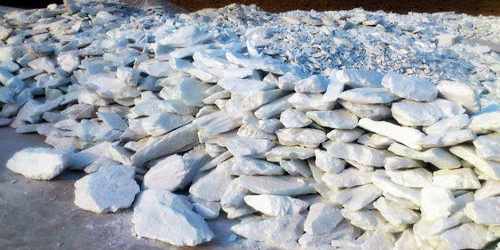
From and Properties of Soapstone –
Soapstone can be found worldwide. However, it is not found in very large quantities. As for the United States, most of the country’s soapstone is quarried in Virginia and Vermont. Soapstone most often forms at convergent plate boundaries where broad areas of Earth’s crust are subjected to heat and directed pressure. Peridotites, dunites, and serpentinites in this environment can be metamorphosed into soapstone. On a smaller scale, soapstone can form where siliceous dolostones are altered by hot, chemically active fluids in a process known as metasomatism.
Unfortunately, fake soapstone can be found from numerous sources. Currently, there are several forms of slates that are being wrongfully advertised as soapstone.
Soapstone is composed primarily of talc and shares many physical properties with that mineral. These physical properties make soapstone valuable for many different uses. These useful physical properties include:
- soft and very easy to carve
- nonporous
- nonabsorbent
- low electrical conductivity
- heat resistant
- high specific heat capacity
- resistant to acids and alkalis
Soapstone is relatively soft because of its high talc content, talc having a definitional value of 1 on the Mohs hardness scale. Softer grades may feel similar to soap when touched, hence the name. No fixed hardness is given for soapstone because the amount of talc it contains varies widely, from as little as 30% for architectural grades such as those used on countertops, to as much as 80% for carving grades.
Soapstone is a rock, and its mineral composition can vary. Its composition depends upon the parent rock material and the temperature/pressure conditions of its metamorphic environment. As a result, the physical properties of the soapstone can vary from quarry to quarry and even within a single rock unit.
The level of metamorphism sometimes determines its grain size. Soapstone with a fine grain size works best for highly detailed carvings. The presence of minerals other than talc and the level of metamorphism can influence its hardness. Some of the harder varieties of soapstone are preferred for countertops because they are more durable than a pure talc soapstone.
Uses of Soapstone –
Soapstone is easy to carve, it is also durable, heat-resistant and has a high heat storage capacity. It has therefore been used for cooking and heating equipment for thousands of years. Soapstone is often used as an insulator for housing and electrical components, due to its durability and electrical characteristics and because it can be pressed into complex shapes before firing. Soapstone undergoes transformations when heated to temperatures of 1,000–1,200 °C (1,830–2,190 °F) into enstatite and cristobalite; on the Mohs scale, this corresponds to an increase in hardness to 5.5–6.5.
The special properties of soapstone make it suitable, or the material of choice, for a wide variety of uses. A number of examples of soapstone use are explained below:
- Countertops in kitchens and laboratories
- Sinks
- Cooking pots, cooking slabs, boiling stones
- Bowls and plates
- Cemetery markers
- Electrical panels
- Ornamental carvings and sculptures
- Fireplace liners and hearths
- Woodstoves
- Wall tiles and floor tiles
- Facing stone
- Bed warmers
- Marking pencils
- Molds for metal casting
- Cold stones
Soapstone can be used to create molds for casting objects from soft metals, such as pewter or silver. The soft stone is easily carved and is not degraded by heating. The slick surface of the soapstone allows the finished object to be easily removed. People can be exposed to soapstone in the workplace by breathing it in, skin contact, or eye contact.
Soapstone does not burn or melt at wood-burning temperatures, and it has the ability to absorb heat, hold heat, and radiate heat. These properties make it an excellent material for making wood-burning stoves. The stove becomes hot and radiates that heat into the room. It also holds heat, keeping the coals hot and often allowing the owner to add more wood without the need for kindling.
Steatite (Soapstone) ceramics are low-cost biaxial porcelains of nominal composition (MgO)3(SiO2)4. Steatite is used primarily for its dielectric and thermal insulating properties in applications such as tile, substrates, washers, bushings, beads, and pigments. It is also used for high-voltage insulators, which have to stand large mechanical loads, e.g. insulators of mast radiators.
Information Sources:
